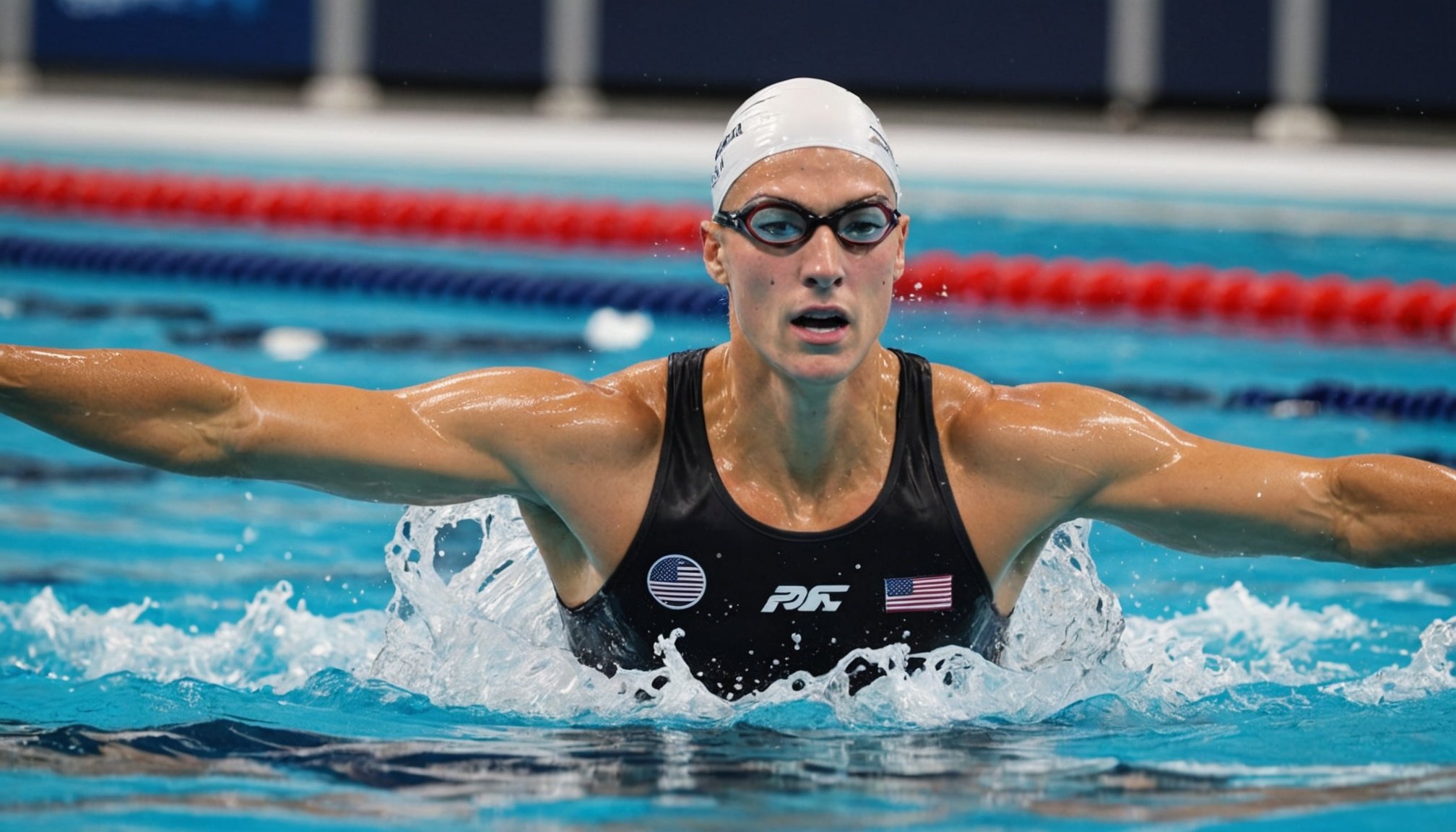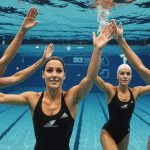Mastering Stroke Technique: A Competitive Swimmer’s Guide to Optimizing Performance Across Events
Understanding the Fundamentals of Swimming Technique
When it comes to competitive swimming, the difference between a medal and a missed opportunity often boils down to the finer details of stroke technique. Elite swimmers understand that every aspect of their swim, from the position of their body in the water to the timing of their breathing, can significantly impact their performance.
Body Position and Streamlining
One of the most critical elements of efficient swimming is maintaining a streamlined body position. This involves keeping the body as horizontal as possible, with the head down and the hips up. This position reduces drag force, allowing the swimmer to cut through the water with less resistance.
In the same genre : Boosting Underwater Stamina: Essential Tips for Synchronized Swimmers
“Streamlining is key because it reduces pressure drag, which is the force that opposes the motion of the swimmer through the water,” explains Coach Jane Smith, a veteran coach at Swimming London. “When you’re streamlined, you’re essentially creating a ‘hull speed’ that allows you to move faster with less effort.”
Here are some tips to improve your body position:
Also read : Maximizing Rowing Performance: The Power of Heart Rate Monitoring for Enhanced Training
- Engage Your Core: Your core muscles play a crucial role in stabilizing your body and maintaining a straight line from head to heels.
- Keep Your Head Down: A slight tilt of the head downwards helps in reducing drag and improving your overall body position.
- Hips Up: Ensure your hips are aligned with your shoulders and ankles to maintain a horizontal body position.
The Mechanics of Each Stroke
Each swimming stroke has its unique mechanics and requirements. Understanding these can help swimmers optimize their technique for different events.
Freestyle Stroke
The freestyle stroke, or front crawl, is the fastest and most common stroke used in competitive swimming. It combines speed and fluidity, making it a favorite among distance swimmers.
- Arm Movement: The freestyle stroke involves alternating arm movements where one arm enters the water while the other arm is in the recovery phase. The arm should enter the water with the palm facing downwards and then pull back with the elbow high.
- Kick: The kick in freestyle is a flutter kick, where the legs move in a small, rapid motion. This kick should be synchronized with the arm movements to maintain a smooth stroke cycle.
- Breathing: Bilateral breathing, where you breathe on both sides, is recommended to maintain symmetry and balance in the water.
Backstroke
The backstroke is another popular stroke that requires a different set of techniques.
- Arm Movement: In backstroke, the arms move in a wide, circular motion with the palms facing upwards. The arms should enter the water with the fingers first and then pull back.
- Kick: The kick in backstroke is also a flutter kick but is slightly wider than in freestyle.
- Body Position: The body position in backstroke is on the back, with the ears, shoulders, and hips aligned.
Butterfly and Breaststroke
The butterfly and breaststroke are more technically demanding strokes but are crucial for well-rounded competitive swimmers.
- Butterfly: This stroke involves a dolphin kick and simultaneous arm movements. The arms move in a wide, circular motion, and the kick is a powerful dolphin kick.
- Breaststroke: Breaststroke involves a frog-like kick and arm movements where the arms move in a circular motion, with the hands turning outwards during the pull phase.
Training Drills to Enhance Technique
Training drills are essential for refining stroke technique and addressing any inefficiencies in your swim.
Drills for Freestyle
- Fist Drill: Swim freestyle with your fists closed to focus on using your forearms and shoulders for propulsion.
- Catch-Up Drill: Swim freestyle with your hands entering the water one after the other, ensuring that one hand catches up to the other before entering the water.
- Kicking Drill: Kick with a kickboard to focus on the timing and efficiency of your kick.
Drills for Backstroke
- Sculling Drill: Use a sculling motion with your hands to focus on the arm movement in backstroke.
- Kick on Your Side Drill: Kick on your side with a kickboard to improve the timing and efficiency of your kick in backstroke.
The Role of Strength and Conditioning
Strength and conditioning are vital components of swim training that can significantly enhance performance.
Upper Body Strength
Upper body strength is crucial for all swimming strokes. Here are some exercises to improve upper body strength:
- Pull-Ups: Pull-ups target the latissimus dorsi muscles, which are essential for the pull phase of most strokes.
- Dumbbell Rows: Dumbbell rows target the trapezius and rhomboid muscles, which help in maintaining good body position.
- Shoulder Press: Shoulder press exercises target the deltoid muscles, which are involved in the recovery phase of the arm movement.
Lower Body Strength
Lower body strength is equally important, especially for the kick.
- Squats: Squats target the quadriceps, hamstrings, and glutes, which are all involved in the kick.
- Lunges: Lunges target the quadriceps, hamstrings, and glutes, and also improve balance and stability.
- Leg Press: Leg press exercises target the quadriceps, hamstrings, and glutes.
Breathing Techniques
Breathing is a critical aspect of swimming technique that can affect performance significantly.
Bilateral Breathing
Bilateral breathing, or breathing on both sides, is recommended for freestyle swimming. Here’s why:
- Symmetry: Bilateral breathing helps maintain symmetry in the body position, reducing drag and improving efficiency.
- Balance: It helps in maintaining balance in the water, ensuring that the body remains streamlined.
Breathing Drills
- Breathing Every 2 Strokes: Practice breathing every 2 strokes to develop a consistent breathing pattern.
- Breathing Every 3 Strokes: For longer events, practice breathing every 3 strokes to conserve energy.
Start and Turn Techniques
The start and turn techniques can make a significant difference in competitive swimming.
Start Technique
- Block Start: The block start involves exploding off the blocks with your feet shoulder-width apart and your hands gripping the block.
- Streamline Position: Immediately after the start, assume a streamlined position to reduce drag and gain speed.
Turn Technique
- Flip Turn: The flip turn is used in freestyle and backstroke events. It involves flipping your body and pushing off the wall with your feet.
- Open Turn: The open turn is used in breaststroke and butterfly events. It involves touching the wall with one hand and then pushing off.
Open Water Swimming Considerations
Open water swimming presents unique challenges that competitive swimmers need to be prepared for.
Navigation
- Sighting: Practice sighting techniques to navigate through the water without losing direction.
- Drafting: Drafting behind other swimmers can help conserve energy and improve your overall time.
Safety
- Swim with a Buddy: Always swim with a buddy in open water to ensure safety.
- Know the Course: Familiarize yourself with the course before the event to avoid any surprises.
Technology and Equipment
Advancements in technology and equipment can also enhance performance.
Swimsuits
Full-body swimsuits have been shown to improve performance by reducing drag and enhancing muscle compression[1].
| Swimsuit Type | Drag Reduction | Muscle Compression |
|---|---|---|
| Full-Body Suit | High | High |
| Jammers | Medium | Medium |
| Briefs | Low | Low |
Goggles and Caps
- Goggles: Goggles help in reducing drag around the eyes and improving visibility underwater.
- Caps: Swim caps reduce drag by smoothing out the hair and reducing friction.
Mastering stroke technique is a continuous process that requires dedication, practice, and a deep understanding of the mechanics involved. By focusing on body position, stroke mechanics, training drills, strength and conditioning, breathing techniques, start and turn techniques, and adapting to open water conditions, competitive swimmers can optimize their performance across various events.
As Coach Jane Smith puts it, “The key to success in competitive swimming is not just about putting in the hours, but about putting in the right hours with the right technique. Every detail counts, and mastering these details can make all the difference between winning and losing.”
By following these guidelines and continuously refining your technique, you can take your swimming to the next level and achieve your competitive goals.











